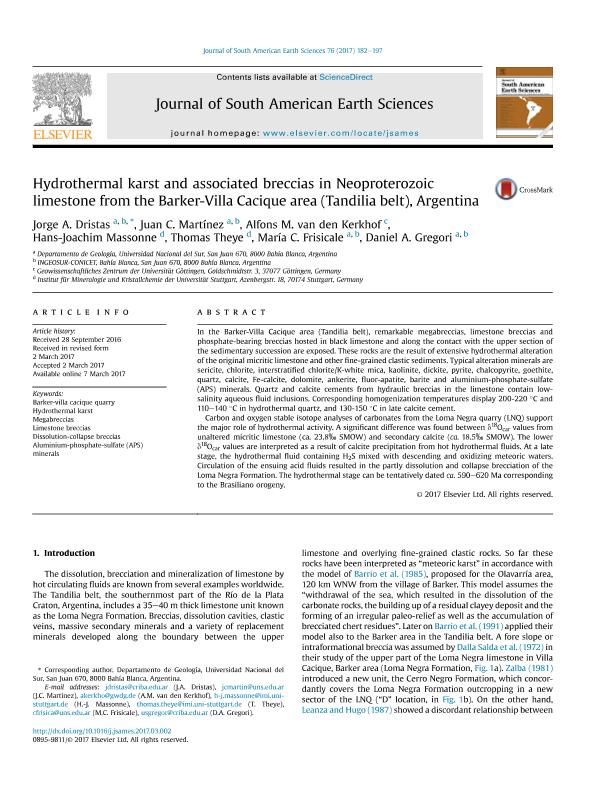Artículo
Hydrothermal karst and associated breccias in Neoproterozoic limestone from the Barker-Villa Cacique area (Tandilia belt), Argentina
Dristas, Jorge Anastasio; Martinez, Juan Cruz ; van den Kerkhof, Alfons M.; Massonne, Hans Joachim; Theye, Thomas; Frisicale, Maria Cristina
; van den Kerkhof, Alfons M.; Massonne, Hans Joachim; Theye, Thomas; Frisicale, Maria Cristina ; Gregori, Daniel Alfredo
; Gregori, Daniel Alfredo
 ; van den Kerkhof, Alfons M.; Massonne, Hans Joachim; Theye, Thomas; Frisicale, Maria Cristina
; van den Kerkhof, Alfons M.; Massonne, Hans Joachim; Theye, Thomas; Frisicale, Maria Cristina ; Gregori, Daniel Alfredo
; Gregori, Daniel Alfredo
Fecha de publicación:
07/2017
Editorial:
Pergamon-Elsevier Science Ltd
Revista:
Journal of South American Earth Sciences
ISSN:
0895-9811
Idioma:
Inglés
Tipo de recurso:
Artículo publicado
Clasificación temática:
Resumen
In the Barker-Villa Cacique area (Tandilia belt), remarkable megabreccias, limestone breccias and phosphate-bearing breccias hosted in black limestone and along the contact with the upper section of the sedimentary succession are exposed. These rocks are the result of extensive hydrothermal alteration of the original micritic limestone and other fine-grained clastic sediments. Typical alteration minerals are sericite, chlorite, interstratified chlorite/K-white mica, kaolinite, dickite, pyrite, chalcopyrite, goethite, quartz, calcite, Fe-calcite, dolomite, ankerite, fluor-apatite, barite and aluminium-phosphate-sulfate (APS) minerals. Quartz and calcite cements from hydraulic breccias in the limestone contain low-salinity aqueous fluid inclusions. Corresponding homogenization temperatures display 200-220 °C and 110–140 °C in hydrothermal quartz, and 130-150 °C in late calcite cement. Carbon and oxygen stable isotope analyses of carbonates from the Loma Negra quarry (LNQ) support the major role of hydrothermal activity. A significant difference was found between δ18Ocar values from unaltered micritic limestone (ca. 23.8‰ SMOW) and secondary calcite (ca. 18.5‰ SMOW). The lower δ18Ocar values are interpreted as a result of calcite precipitation from hot hydrothermal fluids. At a late stage, the hydrothermal fluid containing H2S mixed with descending and oxidizing meteoric waters. Circulation of the ensuing acid fluids resulted in the partly dissolution and collapse brecciation of the Loma Negra Formation. The hydrothermal stage can be tentatively dated ca. 590–620 Ma corresponding to the Brasiliano orogeny.
Archivos asociados
Licencia
Identificadores
Colecciones
Articulos(INGEOSUR)
Articulos de INST.GEOLOGICO DEL SUR
Articulos de INST.GEOLOGICO DEL SUR
Citación
Dristas, Jorge Anastasio; Martinez, Juan Cruz; van den Kerkhof, Alfons M.; Massonne, Hans Joachim; Theye, Thomas; et al.; Hydrothermal karst and associated breccias in Neoproterozoic limestone from the Barker-Villa Cacique area (Tandilia belt), Argentina; Pergamon-Elsevier Science Ltd; Journal of South American Earth Sciences; 76; 7-2017; 182-197
Compartir
Altmétricas



